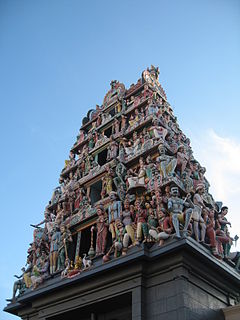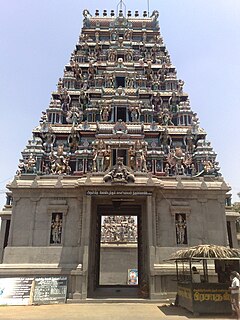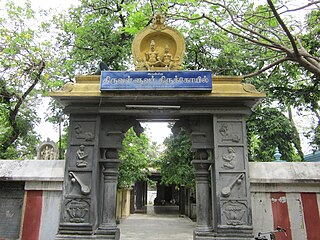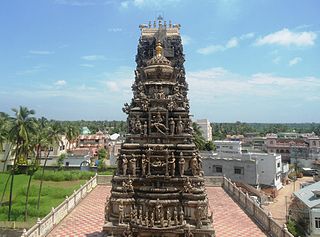Related Research Articles

Mariamman, often abbreviated to Amman, is a Hindu goddess of rain, predominantly venerated in the rural areas of South India. Her festivals are held during the late summer/early autumn season of Ādi throughout Tamil Nadu and the Deccan region, the largest being the Ādi Thiruviḻa. Her worship mainly focuses on bringing rains and curing diseases like cholera, smallpox, and chicken pox. Mariamman is worshipped in accordance with local traditions such as Pidari or the Gramadevatai. She is considered as a guardian deity by many South Indian village-dwellers.

The Sri Mariamman Temple is Singapore's oldest Hindu temple. It is an agamic temple, built in the Dravidian style. Located at 244 South Bridge Road, in the downtown Chinatown district, the temple serves the majority Hindu Singaporeans, Tamilians, in the city-state. Due to its architectural and historical significance, the temple has been gazetted a National Monument and is a major tourist attraction. Sri Mariamman Temple is managed by the Hindu Endowments Board, a statutory board under the Ministry of Community Development, Youth and Sports.

Sangameswarar temple is a temple in Bhavani, in the Erode district, of the Indian state of Tamil Nadu. It is a Hindu temple dedicated to Lord Shiva. It is 15 km from Erode, 30 km from Gobichettipalayam, 56 km from Salem and 106 km from Coimbatore.

The Sri Mahamariamman Temple is the oldest Hindu temple in Kuala Lumpur, Malaysia. Founded in 1873, it is situated at the edge of Chinatown in Jalan Bandar. In 1968, a new structure was built, featuring the ornate 'Raja Gopuram' tower in the style of South Indian temples.

Built in 1833, the Arulmigu Sri Mahamariamman Temple in George Town is the oldest Hindu temple in Penang, Malaysia, and features sculptures of gods and goddesses over its main entrance and facade. It is located at Queen Street, George Town.
Komakkambedu(KKB) is a village located 9 miles north of Thiruninravur. Most of the village is occupied by Vanniyar and Naidu caste. This village is right now facing brain drain. Most of the youngsters have either relocated to the cities or outside India. Many of them are in the USA. Farming is the occupation of most of the villagers. More than twenty Self Help Groups (SHG) are formed for the welfare and development of women.

Kondathu Kaliamman Temple is an Amman temple located at Pariyur near Gobichettipalayam in Tamil Nadu, India. There are other temples, namely Sri Amarapaneeswarar Temple, Sri Adinarayana Perumal Temple and Sri Angalamman Temple nearby.

Pariyur is a panchayat village located near Gobichettipalayam in Erode District of Tamil Nadu state, India. It is located about 3 km from Gobichettipalayam on the way to Anthiyur via Savandapur. It is a religious center with many famous temples including the Pariyur Kondathu Kaliamman temple.
Sri Sithi Vinayagar Temple is a Hindu temple located along Jalan Selangor in Petaling Jaya, Selangor, Malaysia. It is also generally referred to as the PJ Pillaiyar Temple. The resident deity is Ganesha in the form of Sri Sithi Vinayagar. The temple is said to be the largest temple in Malaysia dedicated to Lord Ganesha.

Tirunageswaram Naganathar Temple also known as Rahu Stalam is a Hindu temple dedicated to the deity Shiva, located in Tirunageswaram, a village in the outskirts of Kumbakonam, a town in Tamil Nadu, India. It is significant to the Hindu sect of Saivism as one of the temples associated with the nine planet elements, the Navagraha Stalas, and specifically Rahu. Shiva is worshiped as Naganathar, and is represented by the lingam. His consort Parvati is depicted as Piraisoodi Amman. The presiding deity is revered in the 7th century Tamil Saiva canonical work, the Tevaram, written by Tamil saint poets known as the nayanars and classified as Paadal Petra Sthalam.

Thiruvalluvar Temple, also known as the Ekambareswarar–Kamakshi Temple, is a Hindu temple dedicated to the poet-saint Valluvar in the neighborhood of Mylapore in Chennai, India. The shrine is located within the Ekambareswarar temple complex. Believed to have been constructed in the early 16th century, the temple was extensively renovated in the 1970s. Traditionally believed to be the birthplace of Saint Valluvar, the temple is the oldest ever built to Valluvar. The temple also serves as the venue for meetings of Tamil language enthusiasts. While many consider the temple as the birthplace of Valluvar, some consider it as his samadhi.

Nainativu Nagapooshani Amman Temple [Tamil: நயினாதீவு நாகபூசணி அம்மன் கோயில், romanized: Nayiṉātīvu Nākapūcaṇi Am'maṉ Kōyil - Meaning: Nainativu ; Nagapooshani ; Amman (Goddess)] is an ancient and historic Hindu temple located amidst the Palk Strait on the island of Nainativu, Sri Lanka. It is dedicated to Parvati who is known as Nagapooshani or Bhuvaneswari and her consort, Shiva who is named here as Nayinaar. The temple's fame is accredited to Adi Shankaracharya, a 9th-century Hindu philosopher, for identifying it as one of the prominent 64 Shakti Peethams in Shakti Peetha Stotram and its mention in the Brahmanda Purana. The temple complex houses four gopurams ranging from 20–25 feet in height, to the tallest being the eastern Raja Raja Gopuram soaring at 108 feet high. The temple is a significant symbol for the Tamil people, and has been mentioned since antiquity in Tamil literature, such as Manimekalai and Kundalakesi. The present structure was built during 1720 to 1790 after the ancient structure was destroyed by the Portuguese in 1620. The temple attracts around 1000 visitors a day, and approximately 5000 visitors during festivals. The annual 16-day Mahostavam (Thiruvizha) festival celebrated during the Tamil month of Aani (June/July) - attracts over 100,000 pilgrims. There is an estimated 10,000 sculptures in this newly renovated temple.

The Mangadu Kamakshi Amman Temple is a famous pilgrim destination Hindu temple dedicated to goddess Parvathi, located in Mangadu, a suburb of Chennai, India. The term Mangadu means "Mango Forests or Mango Groves" and as the term implies this must have been a thickly wooded Mango groove in times of yore.
Chennai Om Sri Skandashramam is a Hindu temple dedicated to the deity Murugan in Chennai, India. It is located at Selaiyur, Tambaram, a southern neighbourhood of Chennai. The temple is known of its huge idols of several deities, including Kamala Siddhi Vinayakar, Panchamukha Heramba Ganapathy, Dattatreya, Panchamukha Hanuman, Shaniswara, Ayyapan, goddess Ashtadashabhuja Durga Parameswari, Sarabeswara, goddess Prathiyankira, goddess Bhuvaneshwari, Swaminathaswamy, Sudarshanachakathalwar, Lakshmi Narasimhar, Maha Sahasralingamurthy, Nandikeswarar, goddess Annapurani and Chakra Poorna Maha Meru. There is also an idol of Saint Sathguru Santhananda Swamigal, who built the temple.

The Balathandayuthapani Temple, officially the Arulmigu Balathandayuthapani Kovil, better known as the Waterfall Hill Temple or "Thaneer Malai" by locals, is a temple complex located in George Town, Penang. The main deity of this temple is Murugan. Visitors need to climb 513 stairs to reach the temple. It is the focal point of the Hindu festival of Thaipusam in Malaysia, after the Batu Caves. The hilltop temple, with its seven-storey 21.6m-tall gopuram, has been touted as the largest Lord Murugan temple outside India.

Jalakandeswarar Temple is a temple dedicated to Lord Shiva which is located in the Vellore Fort, in heart of the Vellore city, in the state of Tamil Nadu, India.

Muthumariamman Temple or Arulmigu Sri Muthumari Amman Kovil is a Hindu temple in Matale, Sri Lanka.

Kodandarama Temple is a Hindu temple located in Gollala Mamidada in Kakinada district of Andhra Pradesh, India. The temple is dedicated to Rama, the seventh incarnation of Vishnu. It was built on the banks of Tulyabhaga (Antharvahini), a tributary of Godavari. The temple is notable for its unique architecture and two huge gopurams which stand at 160–170 feet and 200–210 feet. The temple gopurams are adorned with intricately carved statues depicting scenes from Ramayana, Mahabharata, and Bhagavatam.
References
- ↑ "Om Sri Maha Athi Nageswary Amman Hindu Temple Puchong Gateway". Malaysia Traveller.